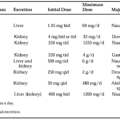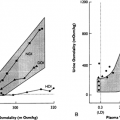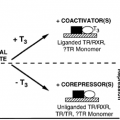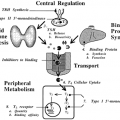SYNTHESIS AND PROCESSING OF PROOPIOMELANOCORTIN
When ACTH is synthesized in the anterior pituitary gland by the corticotropes, it is derived from a much larger precursor, a 241 amino acid peptide, proopiomelanocortin (POMC)5 (Fig. 14-1). The human POMC 8-Kb gene is located on chromosome 2p23.3, consisting of a 400 to 700 bp promoter, three exons, and two introns.6,7 The main regulators of POMC transcription are CRH and glucocorticoids. CRH increases POMC transcription through a cyclic adenosine monophosphate–mediated mechanism, whereas glucocorticoids inhibit transcription. In the pituitary, pro-hormone convertase 1 (PC1) cleaves POMC into ACTH and two other large polypeptides, N-terminal peptide and β-lipotropin.8 The roles of these large peptides, which are cosecreted in equimolar amounts to ACTH, are unknown. β-lipotropin was so named because of a mild lipolytic activity9 that has doubtful relevance in humans. Formerly, β-lipotropin was measured by some investigators as a substitute for ACTH. In the brain, ACTH is cleaved by prohormone convertase 2 (PC2), yielding α-melanocyte-stimulating hormone (α-MSH) and corticotropin-like intermediate lobe peptide (CLIP), which are also produced in the human fetal pituitary intermediate lobe. These peptides are not produced in the adult, where the intermediate lobe is no longer present. Although MSH sequences (α-MSH, β-MSH, γ-MSH) are contained within POMC fragments, ACTH itself has melanotropic action, increasing melanin synthesis, and may itself lead to pigmentation in hypersecretory states. No MSH peptides are released from the anterior pituitary in humans, nor are these peptides found in human blood. MSH activity in human blood results from MSH sequences contained within ACTH and possibly within β-lipotropin and the N-terminal fragment of POMC.
Stay updated, free articles. Join our Telegram channel

Full access? Get Clinical Tree







